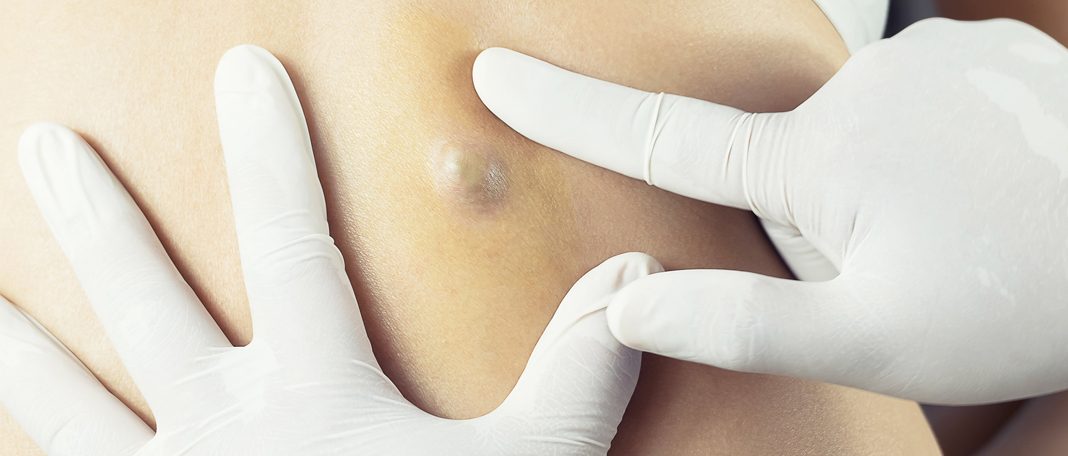Skin bumps and lumps are troublesome factors for the human body, given their abnormal presence on or under the skin. A skin lump or bump is an area of abnormally raised skin in the body.
These bumps and lumps are mostly not harmful – so one can safely rule out the fact that every bump or lump is a symptom of skin cancer. But these tend to cause a sense of discomfort for the person.
Several conditions would cause these skin bumps and lumps – so an accurate diagnosis is important to take the right remedy for the specific condition. Let’s check out the symptoms, causes, and treatment for skin bumps and lumps.
What are the Causes of Skin Lumps
Skin lumps, also known as skin growths or skin masses, can have various causes. They can appear as bumps, nodules, cysts, or other types of raised lesions on the skin. While many skin lumps are harmless and benign, some can indicate an underlying medical condition. Here are some common causes of skin lumps:
- Cysts: Cysts are sacs filled with fluid, pus, or other materials. They can develop anywhere on the body and are often caused by blocked oil glands or hair follicles. Common types of cysts include sebaceous cysts, epidermoid cysts, and pilonidal cysts.
- Lipomas: Lipomas are noncancerous growths composed of fat cells. They usually feel soft and rubbery to the touch and can occur anywhere on the body. Lipomas are typically harmless and painless, but they may be removed if they cause discomfort or affect appearance.
- Skin infections: Various skin infections can lead to the formation of lumps. For example, abscesses are localized pockets of pus caused by bacterial infections. Furuncles (boils) and cellulitis (skin infection) can also result in painful and inflamed lumps on the skin.
- Dermatofibromas: Dermatofibromas are small, firm, and round skin lumps that often appear after an insect bite or minor injury. They are benign and usually harmless, but they may itch or become tender.
- Skin tags: Skin tags are small, soft, and often flesh-colored growths that hang off the skin. They are typically harmless and can occur in areas where skin rubs against skin, such as the neck, armpits, or groin.
- Warts: Warts are caused by the human papillomavirus (HPV). They can appear as raised bumps on the skin, often with a rough or cauliflower-like surface. Warts are contagious and can spread to other parts of the body or to other people through direct contact.
- Allergic reactions: Some skin lumps can be a result of an allergic reaction to certain substances, such as medications, insect bites, or contact with irritants. Hives (urticaria) are a common allergic skin reaction that causes itchy, raised welts on the skin.
- Skin cancer: While most skin lumps are benign, certain types can be indicative of skin cancer. Melanoma, basal cell carcinoma, and squamous cell carcinoma are the most common types of skin cancer. It’s essential to have any suspicious or changing skin lumps evaluated by a healthcare professional. And also get to know how to prevent Skin Cancer for a healthy life.
It’s important to note that this is not an exhaustive list, and there are other less common causes of skin lumps. If you notice any new or changing skin lumps, it is recommended to consult a healthcare professional for an accurate diagnosis and appropriate treatment.
What are the Symptoms of Skin Lumps?
The symptoms associated with skin lumps can vary depending on the underlying cause. Here are some common symptoms that may accompany skin lumps:
- Visible lump or bump: The primary symptom of a skin lump is the presence of a raised lesion on the skin. It may vary in size, shape, color, and texture depending on the underlying cause.
- Skin color changes: Some skin lumps may cause changes in skin coloration. For example, a lump associated with a skin infection or inflammation may appear red, swollen, or warm to the touch.
- Pain or tenderness: Skin lumps can sometimes be accompanied by pain or tenderness, especially if they are inflamed, infected, or pressing on nearby nerves or structures.
- Itching or irritation: Certain types of skin lumps, such as dermatofibromas or allergic reactions, can cause itching or irritation in the affected area.
- Discharge or drainage: In cases where the skin lump is a cyst or an abscess, there may be discharge or drainage from the lesion. This can be fluid, pus, blood, or a combination of these.
- Rapid growth or changes: If a skin lump rapidly increases in size or undergoes significant changes in appearance, it may be a cause for concern. This could potentially indicate an aggressive or malignant growth and should be evaluated by a healthcare professional.
- Ulceration or crusting: In some cases, skin lumps can become ulcerated or develop a crust on the surface. This can occur with certain types of skin cancer or when an underlying infection causes tissue breakdown.
- Systemic symptoms: In more severe cases, skin lumps associated with conditions like skin infections or certain types of cancer may be accompanied by systemic symptoms. These can include fever, fatigue, weight loss, or swollen lymph nodes.
It’s important to remember that these symptoms are not exclusive to skin lumps and can also be present in other skin conditions.
When to Visit a Doctor?
One should visit a doctor if the lumps cause the following symptoms:
- Swelling or painful lumps
- Fluid leakage
- Change in color or shape of the bump
- Intense pain
- High fever
- Hardening of the lump















